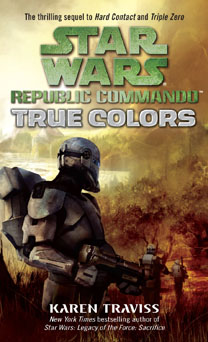Karen Traviss entered the ranks of “Star Wars” authors despite lacking a deep knowledge of the saga, but by her third book, “Republic Commando: True Colors” (2007), her newcomer status begins to serve her well. Like an obsessive kid asking questions about an exciting discovery, she digs into details about the nature of the Clone Wars that George Lucas glossed over in the prequels, and even in “The Clone Wars” TV series. Her desire to learn more about this world leads to serious intellectual expansion of it.
Whereas the first two entries in the “Commando” series focused on specific missions on one planet – Qillura and then Coruscant — “True Colors” delves heavily into the mission of Kal Skirata and his adopted clone sons to find a cure for the clones’ accelerated aging. The first step is to find rogue Kamino scientist Ko Sai.
Almost every plot thread ties in with the theme of the clones’ potential future life outside of warfare. It would be unfair to say Lucas wasn’t interested in these themes; indeed, “The Clone Wars” went on to introduce an AWOL clone in Season 2, just as Traviss introduces Sull here. And certainly, Lucas’ prequels make a point about the incestuous relationship between politicians and the military industry with the way Palpatine orchestrates every step of the Clone Wars. But Traviss digs deeper.
Traviss’ thirst for knowledge makes “True Colors” into a good investigative yarn. Some readers might find that the book is hampered by the fact that we as readers always know the answer – at least broadly – to these mysteries: Palpatine did it. But I’ve always been the type who enjoys the journey of a mystery as much as the destination. Among the issues Traviss digs into – particularly through the character of Besany Wennen, a Republic treasury agent, but also through the clones’ personal musings – are:
- Why is the war spread over so many planets? There doesn’t seem to be a good strategic reason for this on either side. And the reported numbers of clone troopers and Separatist droids – which, if true, would explain the massive theater of war — doesn’t come close to matching what our protagonists have seen in the field, or to what could feasibly be produced.
- What measures are in place for clones who defect? The standard operating procedure is that they are killed by secret clone hit squads. Sull escapes only because the hitmen mistake Darman for Sull, and Darman kills them. Prior to this, A’den and Niner argue about what to do with Sull: Turn him in for deserting (for which they suspect he will be killed), or let him go. It’s the classic “following orders versus doing the right thing” argument. Niner realizes that following orders makes sense in the abstract, but not in a specific instance when someone’s life hangs in the balance.
- Why are most clones loyal to the Republic when they are so mistreated, and when they are faced with overwhelming circumstantial evidence that the Clone Wars are a sham? Loyalty is bred into their genes and reinforced through training. As an ARC trooper is quoted on page 302: “They grow up loyal to the Republic, or they don’t grow up at all.”
- What measures are in place for clones who are forced off the battlefield due to serious injury? Those who are killed are left on the battlefield; those with not-too-severe injuries are patched up and returned to service. When Fi suffers a brain injury that leaves him addled but alive, the official procedure is to euthanize him. As such, Besany and Jaller Obrim – another of Skirata’s allies within the government on Coruscant – break him out of a Republic hospital and hide him on Mandalore.
- How does the Republic know it will need an army of fully grown clones 10 years in the future? Of course, the answer here is clear to readers: Palpatine planned the whole thing. But our protagonists don’t know that for sure, and Traviss reminds us that they have a valid reason to think members of the Jedi Order might be the ringleaders of the scheme, or at least complicit. On page 262, Jedi Bardan Jusik notes that Yoda called it the Clone Wars from the beginning – “What does he know that we don’t?” It’s a valid question, even if the real-world answer might be mundane. Traviss might be planting seeds for tackling the question of why most clones execute Order 66 in the next novel (which was written before the concept of brain chips was introduced in “The Clone Wars” Season 6).
- How were the Kamino cloners paid? Traviss doesn’t answer that question here, although raising the question is fascinating enough. (“Darth Plagueis” would later reveal that Palpatine’s Sith master, Plagueis, paid for the army, and that the Sith Lords used Jedi Master Sifo-Dyas as the oblivious go-between.) But Traviss is not one to gloss over funding or logistical details in plots she creates herself. For example, Skirata aims to take care of as many clones as he can after the war. He gets a huge windfall from Walon Vau’s successful bank robbery, which explains the funding of Skirata’s grand project.
“True Colors” doesn’t just ask questions; it has some fun revelations. We learn that Palpatine wants to track down Ko Sai so he can extend his lifespan. This ties nicely into “Episode III,” where Palpatine reveals to Anakin his interest in eternal life. Even though this is canonically just a lie to get Anakin on his side, “Dark Empire” revealed that Palpatine does indeed want to extend his life, and in that comic series he does so through cloning and the Dark Side power of essence transference.

Palpatine also holds Dr. Uthan, who was working on a clone-killing virus back in “Hard Contact,” in a Republic jail cell. Additionally, the Republic passes legislation that expands its cloning partners beyond the Kaminoans. This helps explain why the clones in the “Thrawn Trilogy” are from an outfit other than the Kaminoans.
Whereas Traviss’ first two “Commando” books were isolated on her original characters, with references to movie characters or other authors’ characters few and far between, “True Colors” shifts gear. While no movie characters have scenes in this book, they are referenced more often. Palpatine’s interest in cloning serves as a backdrop to the missions to find Ko Sai; indeed, Delta Squad’s mission – which comes on the heels of Skirata’s – is at the behest of the Supreme Chancellor himself. Traviss also notes that one of Skirata’s boys, Jaing, is part of the hunt for General Grievous, and she also references Order 66 for the first time chronologically at the time of publication (“Darth Plagueis” would later make a chronologically earlier reference to it).
The author also brings in other EU characters, notably Republic captain Gilad Pellaeon (later Thrawn’s second-in-command). This was Pellaeon’s earliest chronological novel appearance at the time, although he’d pop up again in a later Traviss novel, “No Prisoners,” which is set earlier in the Clone Wars. The “Republic” comics also featured an earlier appearance of Pellaeon. On page 343 of “True Colors,” Traviss adds to the mythology that Pellaeon is a good man who cares about his troops when he rejects an underling’s assertion that clones are less than human. I question whether this portrayal of Pellaeon appropriately follows from Timothy Zahn’s work, where he is a loyal captain to Thrawn, who sees his troops and officers as assets to be exploited.
And a cool nod to the comics comes when the Mandos reference a mad scientist from their own history, Demagol, from the “Knights of the Old Republic” comics.
For the most part, these are references rather than outright cameo appearances. This is the right approach, because they enrich the story without shifting the focus from our heroes. Although Traviss does begin to drift toward her penchant (most notable in her “Legacy of the Force” works) of having her characters explore issues by talking more so than by experiences, there is some good character stuff here.
Second only to the question of clone rights, the horror of marginal war missions is a central theme of “True Colors.” As noted, Fi is injured, and it happens in a mission on Gaftikar where the Republic is helping one local group against another just to put a minor monkey wrench in one aspect of the Separatist supply line. Similarly, and even more starkly, Jedi Etain sees troops and local farmers killing each other on Qillura. Multiple layers of threatened reprisals mean Etain finds herself in the awkward and seemingly inappropriate-for-Jedi position of leading the deportation of farmers.
“True Colors” is not as easy to sum up in tidy bow as most “Star Wars” novels, because it’s one installment in a character-drama serial, rather than something that stands alone. It has a lot going on, and not everything gets resolved here, but this makes it a page-turner, and it has me reaching for the fourth “Commando” entry, “Order 66.”

